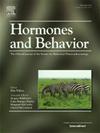Activational and organizational actions of gonadal hormones on the sexual dimorphism of the α6-subunit containing GABAA receptor in Wistar rats with neuropathic pain
IF 2.5
3区 医学
Q2 BEHAVIORAL SCIENCES
引用次数: 0
Abstract
Sex differences in pain perception and response to analgesics are well documented, yet the underlying causes remain poorly understood. Here we investigate the sexual dimorphism in the function of α6GABAA receptors in neuropathic pain, focusing on activational and organizational actions of gonadal hormones. Using the nerve ligation model in rats, we found that the positive allosteric modulator, PZ-ll-029 (30 nmol, it), produced a robust antiallodynic effect in females but not in males. Ovariectomy abolished this effect, while a single dose of estradiol (20 μg/kg sc, −24 h), that returned to physiological serum levels, partially restored it, indicating that the activational effect of estradiol is crucial for α6GABAA receptor-mediated antiallodynia in females. Interestingly, adult or neonatal (at postnatal day 3) orchidectomy did not alter the male's insensitivity to PZ-ll-029, even after estradiol treatment. However, neonatal female's virilization (with testosterone propionate 120 μg/rat at postnatal day 3) induced a male-like insensitivity to PZ-ll-029, that was partial when the ovaries were present and complete after adult ovariectomy. These findings reveal that the neonatal organizational effects of testosterone determine the sex-specific insensitivity of α6GABAA receptors to modulate neuropathic pain, while the activational effects of estradiol can partly maintain the female-typical response, despite early androgen exposure. Our results provide new insights into hormonal regulation of pain modulation and suggest that both developmental exposure and adult status should be considered in basic research and preclinical studies investigating sex-based dimorphisms.
性激素对Wistar神经性疼痛大鼠含GABAA受体α6亚基两性二态性的激活和组织作用
疼痛感知和对镇痛药反应的性别差异已被充分记录,但其根本原因仍知之甚少。本文研究了α - 6gabaa受体在神经性疼痛中功能的性别二态性,重点研究了性激素的激活和组织作用。利用大鼠神经结扎模型,我们发现PZ-ll-029 (30 nmol)在雌性中产生强大的抗变构作用,而在雄性中则没有。卵巢切除消除了这一作用,而单剂量雌二醇(20 μg/kg sc,−24 h)恢复到生理血清水平后,部分恢复了这一作用,表明雌二醇的激活作用对α6GABAA受体介导的雌性抗疼痛至关重要。有趣的是,成人或新生儿(出生后第3天)睾丸切除术并没有改变男性对pz - 1 -029的不敏感,即使在雌二醇治疗后也是如此。然而,新生雌性雄性化(在出生后第3天使用丙酸睾酮120 μg/大鼠)导致pz -l -029对雄性的不敏感,在卵巢存在时是部分的,在成年卵巢切除后完全不敏感。这些发现表明,睾酮的新生儿组织效应决定了α6GABAA受体对神经性疼痛调节的性别特异性不敏感,而雌二醇的激活效应可以部分维持雌性典型的反应,尽管早期暴露于雄激素。我们的研究结果为疼痛调节的激素调节提供了新的见解,并建议在研究基于性别的二态性的基础研究和临床前研究中考虑发育暴露和成年状态。
本文章由计算机程序翻译,如有差异,请以英文原文为准。
求助全文
约1分钟内获得全文
求助全文
来源期刊

Hormones and Behavior
医学-行为科学
CiteScore
6.70
自引率
8.60%
发文量
139
审稿时长
91 days
期刊介绍:
Hormones and Behavior publishes original research articles, reviews and special issues concerning hormone-brain-behavior relationships, broadly defined. The journal''s scope ranges from laboratory and field studies concerning neuroendocrine as well as endocrine mechanisms controlling the development or adult expression of behavior to studies concerning the environmental control and evolutionary significance of hormone-behavior relationships. The journal welcomes studies conducted on species ranging from invertebrates to mammals, including humans.
 求助内容:
求助内容: 应助结果提醒方式:
应助结果提醒方式:


